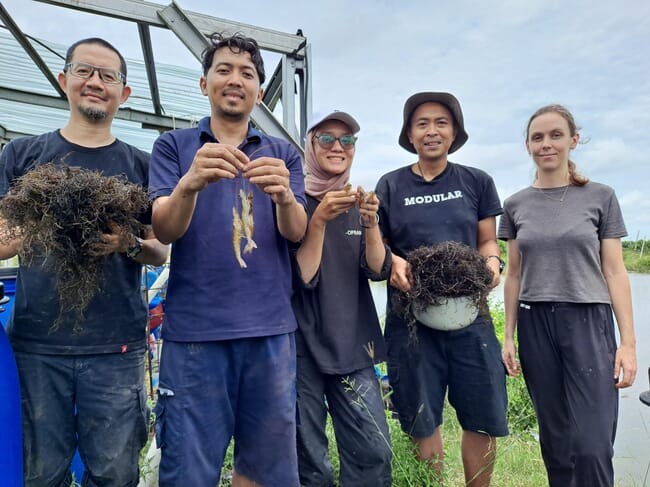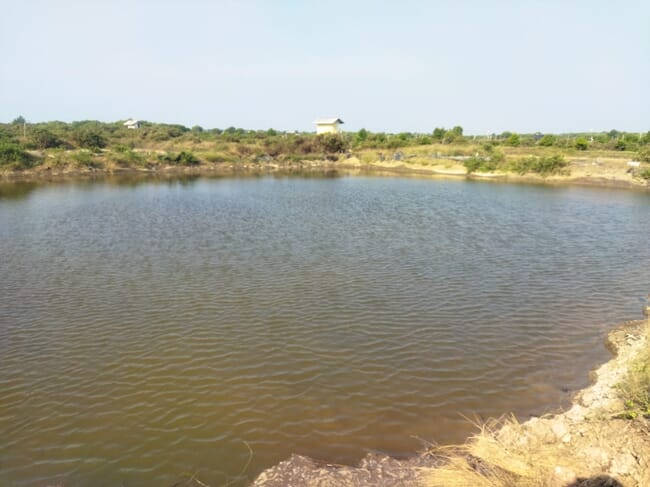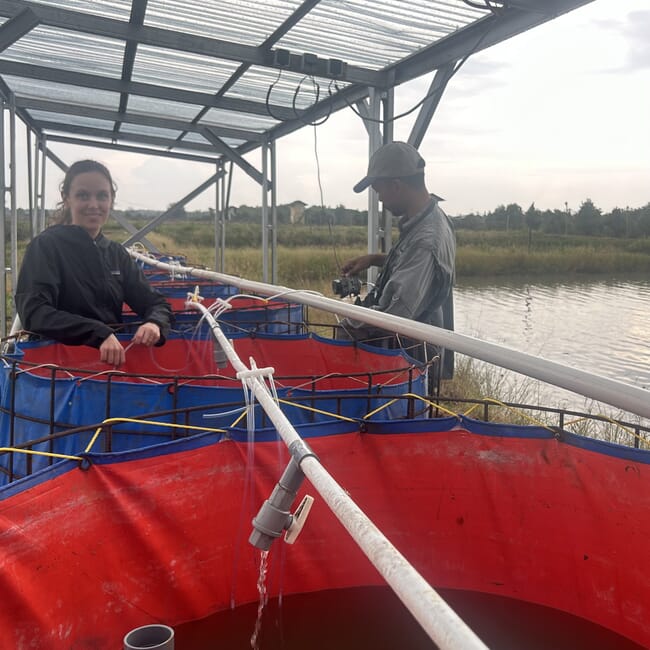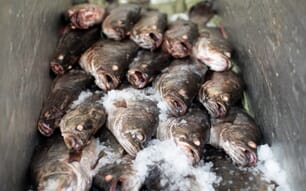
© Sambung Asa
Sambung Asa is a small but ambitious startup co-founded by civil engineers-turned-seaweed farmers Julius Bernardus and Yudistira Wiryawan.
Friends from university and both keen divers, the pair were keen to establish a business that could both restore their country’s damaged coastal ecosystems and support local livelihoods.
“We’re both scuba divers, and we love the sea. One day we asked ourselves, what can we do to empower coastal communities – and also take care of the environment?” Bernardus recalls.
The answer turned out to be farmed seaweed. More specifically, Gracilaria – a species cultivated for its use in producing agar, a gelatinous substance used in the food and biotech industries. Together with a seasoned industry veteran, Maria Gigih, who has worked with seaweed growers and processors since 1994, the Sambung Asa team began by trading seaweed. However, they soon identified a flaw in the value chain.
“We realised the real problem was upstream. The big players focus on processing and trading, but the farming itself – the raw material supply – is unstable. The availability and quality of seaweed were inconsistent. That’s when we decided to focus on farming,” Bernardus explains.
Since this damascene conversion, the team have established three different businesses – a Kappaphycus hatchery in Maluku; a land-based Ulva farm in the south of Central Java; and, perhaps most excitingly, a regenerative aquaculture project that seeks to breathe new life into abandoned shrimp ponds on Java’s north coast.
There, in the past five years, thousands of hectares of shrimp ponds have been deserted following years of poorly practised intensive shrimp farming – as characterised by an overuse of chemicals, poor wastewater management and inadequate biosecurity measures – which led to deteriorating water quality and the outbreak of diseases. These conditions caused catastrophic drops in shrimp survival rates, ultimately rendering the ponds unproductive and forcing farmers to abandon them.
“There are almost 80,000 hectares of abandoned shrimp ponds just on the north coast of Java,” Bernardus says. “During the boom years, most intensive shrimp operations overlooked environmental impacts. By the time more farmers became aware of the consequences, the damage had already been done- and recovery was no longer viable for many. ”
That exodus has had profound social consequences, according to Bernardus. The majority of shrimp farmers are older, and many of them continued operating in degraded ponds by switching to more resilient but less profitable species, or relying on wild fish and shrimp that occasionally entered their ponds. Meanwhile, younger generations – once expected to carry on the farming tradition – have increasingly migrated to cities in search of low-paid work in sectors like construction, or stayed behind in the villages, making ends meet through irregular jobs.
“Back when shrimp farming was thriving, they could stay close to their families and earn a decent living,” he reflects. “Now, many have no choice but to leave their homes – just to survive – while those who stay are left with very limited options.”

Combining shrimp and seaweed
Sambung Asa’s solution combines seaweed and shrimp in a regenerative aquaculture model. In 2024, the team piloted a small-scale experiment by farming Gracilaria in a 1.4-hectare earth pond. The seaweed played a crucial role in bioremediation – removing up to 90 percent of the excess ammonia and nitrates from the water and naturally filtering the pond.
Building on these results, they conducted a follow-up experiment using seven tarp-lined ponds stocked with both seaweed and shrimp. In this setup, shrimp survival rates reached up to 65 percent, compared to the average success rate of 30 percent in traditional farming – representing a 110 percent improvement.
This experiment was conducted in collaboration with Jennifer Kirsch from the coastal science and policy programme at the University of California, Santa Cruz – a programme that pairs masters students with industry players across the globe.
Following the success of the pilot, Bernardus is now looking to build a 10-hectare demonstration farm in West Java. The layout will integrate seaweed and milkfish ponds, shrimp ponds and mangrove reforestation zones.
“This won’t be a high-tech, sensor-driven system. We want to keep it practical and affordable for communities, so we’ll have traditional ponds,” he notes.
However, he does plan one very useful concession to modernity – namely the use of automatic sluice gates that can be programmed to open and close according to the most favourable tides, thereby saving farmers the need to wake up at anti-social hours to do so manually.
In Sambung Asa’s model seaweed ponds are positioned both at the inlet and outlet of the farm, serving as natural biofilters for the water entering and leaving the system. The shrimp ponds sit in the middle, while the seaward perimeter is lined with newly planted mangroves – essential for shoreline protection and long-term ecological balance. And with the added bonus of potentially being eligible for blue carbon credits in the long run.
However Bernardus is keen to emphasise that such credits aren’t part of their business case.
“We don’t use mangroves just for carbon credits. We plant them because we need them – to stop coastal erosion, to bring back biodiversity, and because mangroves are also an integral part of water resource management, serving as natural water filters. The carbon sequestration would be a bonus,” he notes.
A hub and spoke model
A key part of their vision relates to working with satellite farms – dubbed “plasma farms” by Bernardus. These would be operated by local people, trained by Sambung Asa in regenerative aquaculture methods. The startup will operate the core farms and act as an off-taker for the shrimp and seaweed from their neighbours. This would help the project gain critical mass, allowing participants to access premium markets through certification to the standards as the Aquaculture Stewardship Council’s.
“Plasma farms are still owned by the locals,” Bernardus explains. “We just help them farm better – without chemicals – and we buy what they produce. It's about shared prosperity.”
By 2030, Sambung Asa aims to scale this model to encompass 1,000 hectares: 250 hectares of core farms and 750 hectares of plasma farms, spread across multiple islands in the Indonesian archipelago. At full scale, they hope to produce 78,000 tonnes of biomass annually, restore 100 hectares of mangroves, and create 2,000 new jobs.
Bernardus also hopes that it will help prevent the trend of big shrimp investors clearing virgin forests to create farms, abandoning them once disease becomes rife and then starting the process again elsewhere – a trend that keeps them profitable at the expense of the environment.
“This is not just about Java,” Bernardus stresses. “A lot of former shrimp investors are now moving to new islands like Lombok or Sumbawa. We want to show them there’s a better way – don’t repeat the same mistakes.”

© Sambung Asa

© Sambung Asa
A drive to raise funds
While the success of Sambung Asa’s pilot farm suggests that their system has huge potential, challenges remain – notably the need to secure $150,000 to finance the construction of their initial10-hectare demonstration farm.
Another challenge, according to Bernardus, is securing community buy-in. While one neighbour has already adopted the regenerative model, widespread adoption by small scale farmers who don’t have the safety net of financial savings requires proof.
“People need to see the money,” Bernardus points out. “Once they see that this works and brings income, they’ll follow. But first, we have to show them.”
The Sambung Asa team envisions their demonstration farm not just as a commercial venture, but also as a living laboratory. Plans include diversifying into other bioremediative species like oysters and mud crabs, hosting training programmes for women and youth, and eventually scaling across Indonesia.
“We want to create a model that’s replicable. A practical, sustainable system that communities can adapt anywhere,” Bernardus emphasises.
“We want to be the pioneers of regenerative aquaculture. To show that it can work – and that it can work for everyone,” he concludes.

In this setup, shrimp survival rates improved by 110 percent © Sambung Asa








